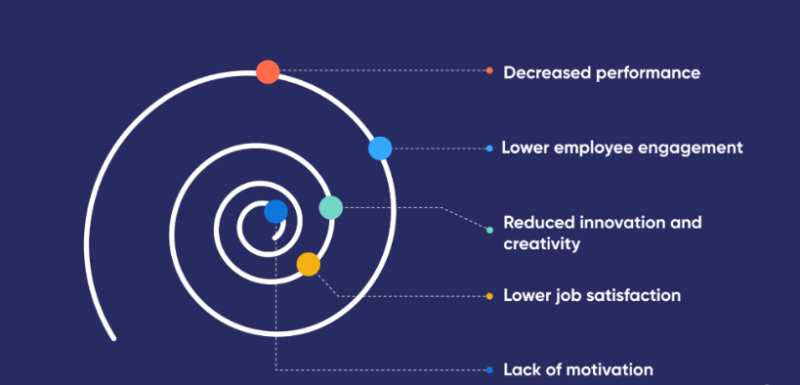

We have all been in that zone. You’re busy with work, and a deadline is approaching. You feel sharp, productive, and energized. Your work motivation is high.
You’re enjoying the work itself and are feeling great about how much progress you’re making.
We call this mental state flow: where an individual is completely immersed in their enjoyment of an activity.
“Motivation” feels almost beside the point — your interaction with the work itself motivates you.
Unfortunately, we’ve also all experienced the opposite feeling when we’re doing something we don’t enjoy.
Time drags on, and you’re keenly aware of it. You’re not any closer to finishing the task. Maybe you’re finding it hard to get started or are dreading the next step.
What is different between these two descriptions? It’s a factor of how motivated we feel. When we feel motivated, we give our best effort and go the extra mile.
If you’re a manager, you’ve probably noticed how employee satisfaction impacts human motivation. You’ve no doubt seen a drop in employee productivity when this happens.
Let’s take a look at what work motivation is, why it matters, and https://www.betterup.com/blog/motivating-a-team.
The concept of work motivation
The concept of motivation has a central position across the field of psychology. Motivation is about our choices: where we expend energy and how we prioritize.
These choices are especially relevant in the world of work.
Being highly motivated at work means we try harder to do our best. Sometimes we are motivated by external factors such as how much we’re being paid, the benefits we are receiving through work, or whether we receive recognition from a supervisor or positive feedback.
Other times, internal factors motivate us, such as how much we enjoy what we’re doing or how important we believe the work is for the company.
Work motivation has a direct impact on our performance. Organizational psychologists have noted that an employee’s performance is impacted by:
- Their ability to do the work
- Their motivation to succeed
This relationship is often expressed as the equation:

MOTIVATION X ABILITY = PERFORMANCE
In other words, it’s not enough to have the skills to do your job. You have to be motivated to put your skills to work.
This is even more important when the tasks are difficult or the work needed is ambiguous because the needs and conditions are changing.
Motivation helps to propel us through challenges and overcome doubt and uncertainty on new tasks.
Why is motivation important?
Given the benefits of having a highly motivated workforce, it’s in a company’s best interest to maximize employee engagement and motivation.
Improving workplace motivation has a number of benefits, including these top five outcomes:

1. Increased performance
A motivated employee will put forth their best effort and generally perform at higher levels.
We can differentiate between a person’s maximal performance and their typical performance.
When individuals are motivated, there is very little difference between the two. That means that they regularly perform to the best of their abilities. But when motivation is low, employees rarely demonstrate their maximal performance.
2. Increased employee engagement
Higher levels of motivation generally translate into employees who are more engaged with their work.
This means that companies will see:
- Decreased turnover and absenteeism
- Healthier relationships among coworkers
- Improved customer service
3. Increased creativity, innovation, and problem-solving
Motivated employees exhibit higher levels of creativity and innovation and are better problem-solvers.
Because they work with greater passion and feel connected to the work they’re doing, they put more energy into these activities.
In the face of challenges, motivated employees take on new behaviors and are creative and flexible in looking for workarounds. As a result, they are able to move past inconveniences.
4. Increased job satisfaction
Employees who show higher levels of motivation also report higher levels of job satisfaction. Employees who are more satisfied are more efficient, have higher levels of productivity, and care more about what they’re doing.
5. Increased employee well-being
Employees who are motivated report higher states of well-being and better mental fitness. When they are energized and excited to do their work, their physical and mental health improves.
In fact, this relationship becomes cyclical.
Higher motivation leads to an increased sense of well-being. At the same time, improving employee well-being leads to higher levels of motivation.
The downward spiral of low work motivation
Work motivation is an important lever for managers, and motivating others is a key leadership skill. Let’s consider the consequences of a demotivated workplace. In addition to losing the benefits listed above, there are other costs.

Decreased performance
This hurts in the present, leading to higher costs, lower quality work, and missed revenue opportunities. But it also hurts in the long term.
That’s because companies with unmotivated employees are unprepared to respond to changing conditions.
They’ll have a less adaptable and future-ready workforce and won’t be ready to take on future opportunities.
Lower employee engagement
When employee engagement is low, it leads to:
- Higher turnover
- Absenteeism
- Decreased customer satisfaction
- Potentially increased employee conflicts and incidents
Reduced innovation and creativity
As a result of reduced creativity and ideas, fewer interesting opportunities or challenges will emerge. This narrows the innovative and creative potential of the organization.
Lower job satisfaction
This hurts recruiting and retention and can lead to safety and quality issues.
Lack of motivation
Just as motivation can be contagious, so can be the lack of it. A few unmotivated team members, if left unaddressed, can demotivate others around them.
Others may start to question themselves for working so hard or question the ability of the team to deliver impact with such low commitment.
Types of work motivation
There are numerous theories of motivation across the field of psychology. Several specifically relate to the psychology of the workplace.
We’ll explore two such theories of motivation because they can help us understand what employees are experiencing.
The first motivation theory we’ll look at is the difference between intrinsic and extrinsic motivators. The second is Herzberg’s two-factor model.
Intrinsic vs. extrinsic motivation
In its simplest definition, intrinsic motivation refers to being motivated by the activity itself. The work is its own reward.
Extrinsic motivation refers to doing work for a reward other than the joy, learning, or meaning that comes from doing the work itself. In other words, an external reward.
Anything we receive for doing work can be considered an extrinsic motivator.
Motivation examples include:
- Compensation
- Bonuses or a promotion
- Privileges
- Awards
- Recognition
- Praise from a supervisor
- Less tangible rewards such as a change in status
This is an important differentiation because of their impact on performance.
People tend to perform better when they’re intrinsically motivated because they care deeply about the activity. They are more likely to lose themselves in their work and experience a state of flow.
Herzberg’s two-factor model:
This model demonstrates that there are factors that lead to high motivation and job satisfaction and ones that lead to the opposite.
However, they aren’t the same factors.
For example, the factors that lead to higher motivation include:
- A sense of achievement
- Recognition from others
- Opportunities for advancement
When these factors are present, we feel more motivated to do our best work. Herzberg called these factors Motivators and demonstrated their contribution to job satisfaction.
Herzberg contrasted these Motivators with what he called Hygiene Factors.
These are the features that are needed to be present in order to avoid job dissatisfaction.
Hygiene Factors include:
- Safe working conditions
- Adequate compensation
- Fair company policies
- High-quality supervision
While the presence of these factors doesn’t lead to higher levels of motivation, the absence of them leads to lower levels of motivation.

This model allows us to think through the aspects of the workplace that need to be present to meet basic needs (Hygiene.)
Once these are met, we can strive for those factors that lead to feelings of growth and achievement (Motivators.)
Losing motivation
Part of learning to manage people is learning how to motivate resistant employees to do what you need.
But motivation is often not about laziness or work ethic. At times, even the hardest working employees can lose their motivation.
In fact, maybe you’ve found yourself feeling less motivated than usual recently. 2020 brought challenges that most of us have never seen before.
We’re:
- Interacting with coworkers through video screens
- Helping our children with online school
- Missing relatives and friends we don’t see regularly
- Worrying about health and finances more often
It’s not surprising that these stressors have led many employees to feel more overwhelmed and less motivated to do their best work. While they still put in their time, they are contributing less energy and passion.
Besides exhaustion and overwhelm, what causes good, formerly-motivated employees to lose their drive? Let’s take a look at five culprits.

1. Lack of impact, purpose, or meaning
Many employees will work hard if they believe they are making a difference.
This can be a difference to their colleagues, the company, the customer, or even the world. If time passes and an expected impact doesn’t materialize, or the impact disappears, motivation might fade as well.
2. Disempowerment and restrictive conditions
In the performance equation above, motivation is a separate factor from ability. In reality, if your ability to do something decreases significantly, that also affects motivation.
This might be from a loss of resources, tighter timelines, or new policies that prevent collaborating with customers.
3. Mastery / lack of growth
Many highly talented employees enjoy challenging themselves and learning rapidly. This is especially true if the learning positions them to achieve professional aspirations.
The harder the quest, the more motivated they are.
If they find themselves in a situation where they are no longer being stretched, they may miss the constant learning and become significantly less motivated.
4. Negative work conditions
Decreased sense of connection to the organization or teammates and a lack of belonging can take the air out of motivation.
This type of damage might be a result of:
- Getting a new manager
- Changes to team dynamics that result in unproductive friction or loss of psychological safety
- An unsatisfactory resolution to an incident, especially if it violates the employee’s core values.
5. Fear or threat
Fear can be a powerful motivator in the moment, but it is hard to sustain. It tends to shut us down into tunnel-vision. Fear doesn’t create the conditions for adaptive, creative performance that reinforce motivation.
How to get motivated to work
What changes can we make in our work environment to continue motivating employees?
To understand this, we first need to ask: what motivates employees?
The good news is that there are clear steps we can take. Here are ten things managers and leaders can do in order to improve motivation. Five relate to the work itself, and five are about how you treat employees.
5 ways to increase motivation through the work
In order to tap into employees’ intrinsic motivation, first, we turn our attention to the work itself:
- Make the work more interesting. Ensuring that work has variety is essential to helping employees’ motivation. When employees experience variety, it reduces boredom and keeps them engaged in the work.
- Ensure employees have adequate autonomy. Having adequate autonomy gives employees a perceived sense of control over how they get their work done.
Employees who are enabled to do their jobs with greater autonomy feel more motivated, satisfied, and creative. - Connect the work to its significance. Helping employees understand their work’s value is critical to connecting them to the bigger picture. Feeling that you’re doing meaningful work that is relevant to key organizational goals is a strong intrinsic motivator.
- Assess workload. Feeling stressed and overworked is sure to hamper employees’ motivation. It’s important to take time to assess whether employees have adequate resources and time to complete their work.
Leaders should ensure that workload matches capacity and find ways to make necessary changes. - Offer opportunities to learn. Employees show higher levels of motivation when they continue to learn and apply new skills over time. It helps them avoid feeling stagnant and instead look to future opportunities for continued growth.
5 ways to increase motivation through employee relationships
Let’s turn our attention to how we treat employees and how we can use our relationships with them to increase motivation:
- Focus on what people value. Managers must determine what each person on their team values in order to understand what factors will motivate them.
If you want to earn someone’s trust and respect, first strive to understand who they are and what matters to them. - Ask questions. Rather than making assumptions about how associates are doing, leaders are encouraged to ask questions. It isn’t always possible to “read” someone else’s motivation from the outside.
Asking employees about their experience will help them feel heard and provide leaders with valuable information. - Offer support. At a time when many employees report feeling more stressed than they did a year ago, leaders should be offering their support. Helping to remove obstacles or sharing resources can help employees who are feeling demotivated by stress.
- Create a positive working environment. Leaders should strive to create positive and healthy work environments. This happens through healthy communication, employee recognition, and strong relationships.
These environments help employees feel valued and motivated to do their best work. - Celebrate progress, not just completion. Celebrating small wins — rather than waiting until the final goal has been reached — can help keep people motivated.
We can acknowledge the progress we’re making and celebrate how far we’ve come as we achieve smaller, more specific goals.
It’s important to check in with employees on how they perceive your efforts and how motivated they feel. Organizations should conduct engagement surveys that measure employees’ perceptions and reactions.
Leaders are then responsible for using the data from these surveys. This allows them to look for opportunities to consider how they’re treating their teams and address key motivators.









You must be logged in to post a comment Login